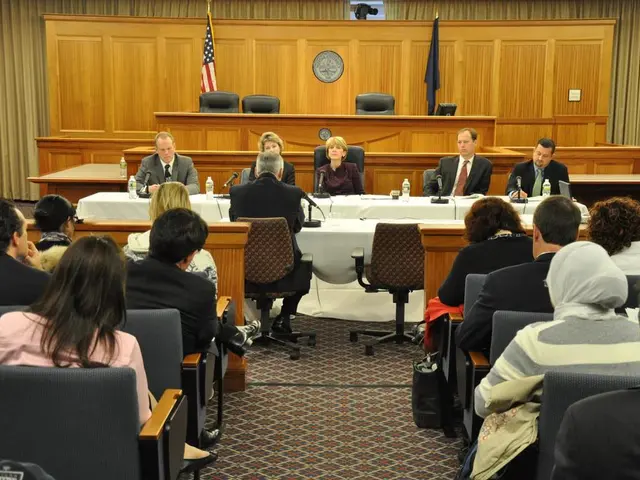Essential Stroke Knowledge for Individuals Under 45 Years
In a concerning trend, strokes are no longer just a health concern for the elderly. According to recent studies, strokes are increasingly affecting younger populations, including those in low- and middle-income countries. This silent epidemic underscores the importance of understanding the signs and preventive measures for this potentially debilitating condition.
A stroke occurs when there is a loss of blood flow to the brain, causing brain cells to die and resulting in brain damage, disability, or even death. This medical emergency can strike at any age, and it is crucial to recognize the signs quickly to ensure immediate treatment.
Some common stroke symptoms generally appear suddenly and may include weakness or numbness on one side of the body, particularly affecting the face, arm, or leg; drooping or weakness of one side of the face; difficulty speaking or understanding speech, slurred speech, or inability to speak; vision problems, such as sudden blurring, double vision, or loss of vision in one eye; sudden confusion or difficulty understanding speech; loss of balance, dizziness, or difficulty walking, leading to falls; severe headache, dizziness, nausea, or vomiting, especially in hemorrhagic strokes; and additional symptoms such as sudden tinnitus, neck or facial soreness, sudden sleepiness, or urinary incontinence.
The American Heart Association/American Stroke Association aims to increase public recognition of common stroke symptoms, with younger people having a good chance of remembering the acronym F.A.S.T., which stands for Face drooping, Arm weakness, Slurred speech, Time to call 9-1-1.
Sadly, awareness about stroke symptoms is lacking among younger adults. A survey revealed that nearly 30% of younger adults were unable to name all five common stroke symptoms, and 3% could not name any stroke symptoms at all. This lack of knowledge can have dire consequences, as immediate treatment is crucial in minimizing brain damage and increasing chances of recovery.
The good news is that 80% of strokes are preventable, according to an editor's note. Some heart-healthy lifestyle changes to prevent strokes include getting regular exercise, managing blood pressure, stopping smoking, managing stress, maintaining a healthy weight, and eating a healthy heart diet. Dr. Michael Cutler offers advice on what to eat and what to supplement to ward off stroke.
Dr. Elizabeth Klodas asserts that if lifestyle-related risk factors could be controlled, 90% of all strokes could be eliminated. The increase in stroke risk among younger people is linked to the rise in obesity-related lifestyle risk factors, such as hypertension, diabetes, and high cholesterol. In 2005-2006, 28% of young adults were obese, and this rate jumped to 35.7% a decade later.
Television advertising exposure can also play a role in increasing the ability of communities to identify stroke warning signs for individuals under the age of 65. Recognizing these symptoms quickly is crucial because stroke is a medical emergency. The faster treatment is received, the more likely the long-term effects can be minimized or prevented.
In conclusion, it is essential for younger adults to be aware of the signs of a stroke and to take preventive measures to reduce their risk. By recognizing the symptoms early and seeking immediate medical attention, we can significantly improve outcomes and preserve quality of life and function. Let us take a proactive stance against this silent epidemic and promote awareness and prevention among our communities.
Sources: 1. Advertising Strategies to increase public knowledge of the warning signs of stroke from the AHA 2. Nearly one in three young adults in the US not knowing common stroke symptoms from Science Daily 3. Strokes among younger people on the rise from Texas Medical Center 4. Stroke Facts from the Centers for Disease Control (CDC) 5. Stroke information from MedlinePlus.
- To prevent strokes, which account for 80% of cases being preventable, one can adopt a heart-healthy lifestyle by engaging in regular exercise, managing blood pressure, quitting smoking, managing stress, maintaining a healthy weight, and adhering to a healthy heart diet.
- About one in three young adults in the U.S. are unaware of common stroke symptoms, which can have serious implications as immediate treatment is crucial in reducing brain damage and increasing recovery chances.
- Awareness about stroke symptoms is essential, especially considering the concerning trend of strokes affecting younger populations, including those in low- and middle-income countries.
- Science and medical research play a vital role in understanding the signs and preventive measures for strokes, a potentially debilitating condition that is increasingly affecting younger populations.
- A healthy lifestyle encompasses not only physical health but also mental health, nutrition, and fitness-and-exercise, all of which contribute to overall cardiovascular health and personal growth.
- Education and self-development are crucial in combating the rise in strokes among younger people, as knowledge about risk factors and preventive measures can lead to improved lifestyle choices and career development.




